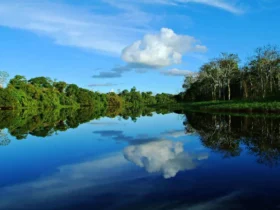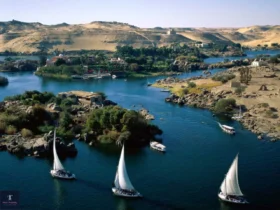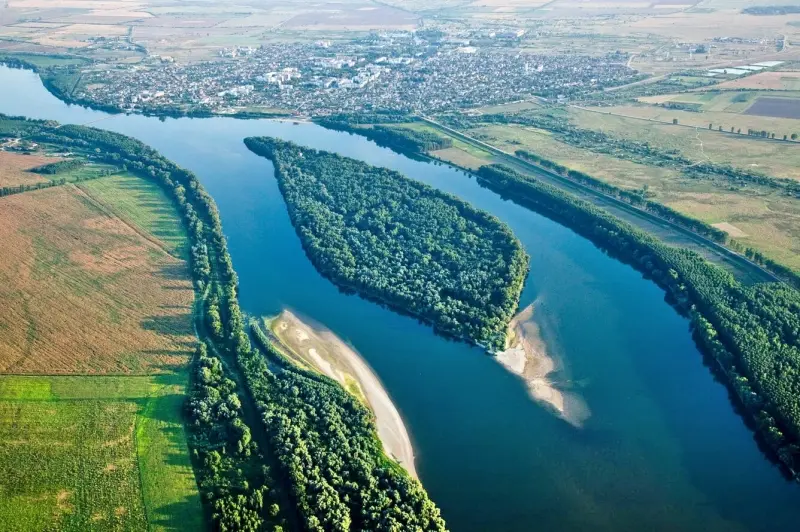A river is a natural flowing source of water, usually freshwater, that flows towards an ocean, sea, lake, or another river.
There are many factors that influence the measurement of the total length of a river, so the lengths of many rivers are approximate. In the article, we will synthesize the fifteen longest rivers in the world. Let’s explore and admire these beauties together!

These rivers play significant roles in the regions they flow through, providing water resources, supporting ecosystems, and contributing to the social, cultural, and economic aspects of the surrounding areas.
1. Amazon River
The Amazon River is the largest river in South America and the world’s largest river by discharge volume. It has a total length of approximately 6,400 kilometers (4,000 miles), making it one of the longest rivers in the world. It flows through several South American countries, including Brazil, Peru, Colombia, Bolivia, Ecuador, Venezuela, and Guyana. It has a massive drainage basin that covers an area of approximately 7,062,000 square kilometers (2,722,000 square miles).

The Amazon River is not only an essential natural resource but also a place of immense beauty and ecological importance. It holds a special place in South American culture and continues to captivate visitors from around the world with its vastness and ecological richness.
2. Nile River
The Nile River is one of the most famous rivers in the world and is widely known as the longest river. It has a total length of approximately 6,650 kilometers (4,130 miles), making it the longest river in the world. It flows through eleven countries in northeastern Africa, including Egypt, Sudan, South Sudan, Ethiopia, Uganda, Congo-Kinshasa, Kenya, Tanzania, Rwanda, Burundi, and Eritrea.

The Nile River’s immense length, historical significance, and economic importance have made it a symbol of life and prosperity for the people living along its banks. It continues to be a vital waterway and a source of fascination for people around the world.
3. Yangtze River
The Yangtze River, also known as the Chang Jiang, is the longest river in Asia and the third-longest river in the world. It stretches approximately 6,300 kilometers (3,915 miles) from its source in the Tanggula Mountains in Qinghai Province, western China, to its mouth near Shanghai, where it empties into the East China Sea. It flows through several provinces and major cities, including Chongqing, Wuhan, and Nanjing.

The Yangtze River’s immense length, cultural significance, and economic importance make it a remarkable natural feature of China. It continues to be a source of inspiration, a lifeline for transportation and commerce, and a symbol of China’s rich history and natural beauty.
4. Mississippi-Missouri River System
The Mississippi-Missouri River System comprises two major rivers: the Mississippi River and the Missouri River. The combined length of the Mississippi-Missouri river system is approximately 6,275 kilometers (3,902 miles). The rivers flow through the United States, traversing states such as Minnesota, Missouri, Illinois, Louisiana, and others, before emptying into the Gulf of Mexico.

The Mississippi-Missouri River System is an iconic feature of North America, representing the power and beauty of its rivers. It continues to be a dynamic and ever-changing natural resource, serving as a lifeline for various human activities and supporting diverse ecosystems and communities.

5. Yenisei River
The Yenisei River, also spelled Enisei, is one of the longest rivers in the world and the largest river system flowing into the Arctic Ocean. It stretches approximately 5,539 kilometers (3,445 miles) from its headwaters in the Mongolian Altai Mountains to its mouth in the Kara Sea, part of the Arctic Ocean. It flows through Mongolia and then across the vast territory of Russia, passing through the regions of Tuva, Khakassia, Krasnoyarsk Krai, and ending in the Taymyr Peninsula.

The Yenisei River’s immense length, ecological significance, and economic importance make it a significant natural feature of Siberia and the Arctic region. It serves as a lifeline for the communities that depend on it and provides a unique environment for wildlife and exploration.
6. Yellow River
The Yellow River, also known as the Huang He, is the second-longest river in China and one of the most significant rivers in Chinese history and culture.
It stretches approximately 5,464 kilometers (3,395 miles) in length, making it the sixth-longest river in the world. It originates in the Bayan Har Mountains in Qinghai Province, western China, and flows eastward through nine Chinese provinces, including Qinghai, Sichuan, Gansu, Ningxia, Inner Mongolia, Shaanxi, Shanxi, Henan, and Shandong. The river eventually empties into the Bohai Sea in the eastern part of the country.

The Yellow River, with its historical importance, agricultural significance, and cultural heritage, symbolizes the spirit of the Chinese people and remains an integral part of China’s identity and development. Efforts to balance its conservation, water management, and sustainable use are crucial for the future of the river and the people who depend on it.
7. Ob-Irtysh River System
The Ob-Irtysh is a river system formed by the confluence of two major rivers, the Ob and the Irtysh. It is formed by the merging of the Ob River and the Irtysh River in western Siberia, Russia. The Ob River, originating from the Altai Mountains, is the main source, while the Irtysh River, originating in Mongolia, is the largest tributary. The combined length of the Ob-Irtysh River system is approximately 5,410 kilometers (3,360 miles).

The Ob-Irtysh River system’s extensive length, economic importance, and ecological value make it a significant feature of western Siberia. It serves as a lifeline for transportation, power generation, and the conservation of natural resources.

8. Paraná River
The Paraná River is one of the longest rivers in South America. It spans approximately 4,880 kilometers (3,032 miles) in length, making it the second longest river in South America after the Amazon River. It begins in the highlands of southern Brazil, near the border with Brazil and Paraguay, and flows southward before merging with the Uruguay River and eventually emptying into the Río de la Plata estuary in Argentina.

The Paraná River’s length, economic significance, and ecological value make it an important natural feature in South America. It not only serves as a vital transportation artery but also provides habitats for diverse ecosystems and contributes to the livelihoods of the communities along its banks.
9. Congo River
The Congo River is one of the longest rivers in Africa, with a length of approximately 4,700 kilometers (2,920 miles). It ranks as the second longest river in Africa after the Nile. It has an enormous drainage basin that covers parts of nine countries, including the Democratic Republic of the Congo, Angola, Zambia, Tanzania, Cameroon, and others.

The Congo-Chambeshi River system is of immense significance to the African continent. The Congo River, with its vast length and drainage basin, plays a vital role in transportation, trade, and sustenance for millions of people. The Chambeshi River, as a significant tributary, contributes to the overall hydrological dynamics and ecological balance of the Congo River system.
10. Amur-Argun River System
The Amur-Argun River System is a transboundary river system located in Northeast Asia, forming the border between Russia and China. It consists of two main rivers, the Amur and the Argun.
The total length of two rivers is approximately 4,444 kilometers (2,761 miles) .The Amur River flows through the Russian Far East, passing through regions such as Heilongjiang, Khabarovsk Krai, and Amur Oblast, before discharging into the Tatar Strait, which connects to the Sea of Japan. The Argun River passes through the Inner Mongolia Autonomous Region of China and the Russian regions of Buryatia and Zabaykalsky Krai.

The Amur-Argun River System is a significant waterway that connects Russia and China, supporting ecosystems, economies, and human settlements along its course. Its rich biodiversity and cultural importance make it a fascinating area to explore and appreciate the wonders of nature and the intricate relationship between humans and rivers.

11. Lena River
The Lena River is one of the major rivers in northeastern Siberia, Russia. It stretches for approximately 4,400 kilometers (2,734 miles) from its headwaters in the Baikal Mountains to its delta in the Laptev Sea, part of the Arctic Ocean. It is one of the longest rivers in the world.

The Lena River’s immense length, ecological importance, and cultural significance make it a prominent feature of Siberia. It provides transportation, sustains diverse ecosystems, and serves as a subject of scientific study and exploration.
12. Mekong River
The Mekong River is one of the major rivers in Southeast Asia, flowing through several countries in the region. It stretches for approximately 4,350 kilometers (2,703 miles) from its source in the Tibetan Plateau of China to its delta in Vietnam. It is the 12th longest river in the world and the 7th longest in Asia.

The Mekong River’s length, importance for transportation and agriculture, ecological diversity, and cultural significance make it a significant natural feature of Southeast Asia. It serves as a vital resource for the region, supporting livelihoods, biodiversity, and the interconnectedness of the countries it traverses.
13 Mackenzie–Peace–Finlay
The Mackenzie–Peace–Finlay is a river system in western Canada that encompasses the Mackenzie River, Peace River, and Finlay River. it has total length 4.241 kilometers (2.637 miles).
Mackenzie River: The Mackenzie River is stretches from Great Slave Lake to the Beaufort Sea. It is the longest river in Canada and one of the longest in North America.

Peace River: The Peace River is one of the major tributaries of the Mackenzie River. It flows from British Columbia to Alberta, where it joins the Slave River to form the Mackenzie River.

Finlay River: The Finlay River is a significant tributary of the Peace River. It flows through northeastern British Columbia before merging with the Parsnip River to form the Peace River.

The interconnectedness of the Mackenzie River, Peace River, and Finlay River forms a significant river system in western Canada. It plays a crucial role in the region’s ecology, economy, and cultural heritage, and its waters contribute to the larger Mackenzie River basin and the Arctic Ocean.
14. Niger River
The Niger River is a major river in West Africa, flowing through several countries in the region. It is approximately 4,180 kilometers (2,600 miles) long, making it the third-longest river in Africa. It flows through several countries, including Guinea, Mali, Niger, Benin, and Nigeria. The river has its source in the Guinea Highlands in southeastern Guinea.

The Niger River, with its length, importance for agriculture, biodiversity, and cultural significance, is a significant natural feature in West Africa. It serves as a vital resource for the region, supporting livelihoods, ecosystems, and the interconnectedness of the countries it traverses.
15. Murray-Darling Basin
The Murray-Darling Basin is a river system in Australia, encompassing the Murray River and the Darling River, along with their tributaries and associated water catchment areas.
Murray River: The Murray River is Australia’s longest river, stretching approximately 2,508 kilometers (1,558 miles) in length. It originates in the Australian Alps and flows through the states of Victoria, New South Wales, and South Australia before reaching the Southern Ocean.

Darling River: The Darling River is one of the major tributaries of the Murray River, originating in northern New South Wales. It flows for approximately 1,472 kilometers (915 miles) before merging with the Murray River near Wentworth in New South Wales.

The Murray-Darling Basin plays a significant role in Australia’s agricultural production, water management, and environmental conservation. It is a vital resource for communities, industries, and ecosystems in the region, and efforts are ongoing to ensure sustainable use and protection of its water resources.
These rivers span multiple continents and countries, influencing the landscapes, ecosystems, and cultures of the regions they flow through. They are vital lifelines, providing water resources, transportation routes, and supporting diverse wildlife and human populations.
Above are the top 15 longest rivers in the world that we collected from sources. Hope this information is useful to you. Please visit our website for more exciting information!




